SUZUKI GRAND VITARA 2008 3.G Operating Manual
Manufacturer: SUZUKI, Model Year: 2008, Model line: GRAND VITARA, Model: SUZUKI GRAND VITARA 2008 3.GPages: 40, PDF Size: 1.23 MB
Page 11 of 40

Downloaded from www.Manualslib.com manuals search engine Starting a Cold and Warm Engine
(For Gasoline Engine Model) With your foot off the ~cceler~to~. pedal,
crank the engine by turning the Ignition key to "START". Release the key when the
engine starts.
CAUTION
• Stop turning the starter immediately after the engine has started or the starter system can be dam-
aged. .
• Do not crank the engine for more
than 15 seconds at a time. If the
engine doesn't start on the first try,
wait about 15 seconds before trying again.
If the engine does not start after 15 seconds of cranking, wait about 15 seconds,
then press down the accele.rator pedal. to 1/3 of its travel and try cranking the engine
again. Release the key and accelerator
pedal when the engine starts.
If the engine still does not start, try holding
the accelerator pedal all the way to the
floor while cranking. This should clear the
engine if it
is flooded.
(For Diesel Engine Model)
Cold engine Turn the ignition switch to the. "~N" position and wait until the glow plug Indicator goes
out if it comes on. Crank the engine by turning the ignition key to "START". Release the key when the engine starts.
CAUTION
• The starter is allowed to crank the
engine up to 30 secon~s. If the
engine failed to start, walt 15 seconds, then restart cranking. Even if the third trial failed, consult authorized SUZUKI dealer. • If the engine is started after long
time parking at extremely cold
atmosphere such as the ambient
temperature
is below -20o~, release ignition key from start POSItion and stop cranking after confirming the engine speed increase
around 800 to 1000 rpm.
Warm engine
Crank the engine by turning the ignition
key to "START". Release the key when the engine starts.
OPERATING YOUR VEHICLE
Caution when stopping the engine with turbocharger
When stopping the engine after ~Iim~ing or high speed driving, let the ~n.gl~e Idle for
about one minute or more (If It IS not prohibited) to cool down the turbocharg~r an~ engine oil. This is to pr~vent the en!;llne 011 from over-deteriorating. Deteriorated
engine oil will damage the bearings of the
turbocharger.
Restarting
F9Q diesel engine after fuelempty stop
The engine stops if the engi~e feels fuel
emptiness. To restart the engine, stop the vehicle, fill the tank (minimum 5 liters) and
operate the manual priming pump (1) attached to the fuel filter until resistance is felt. Then perform the engine starting procedure.
3-10
Page 12 of 40
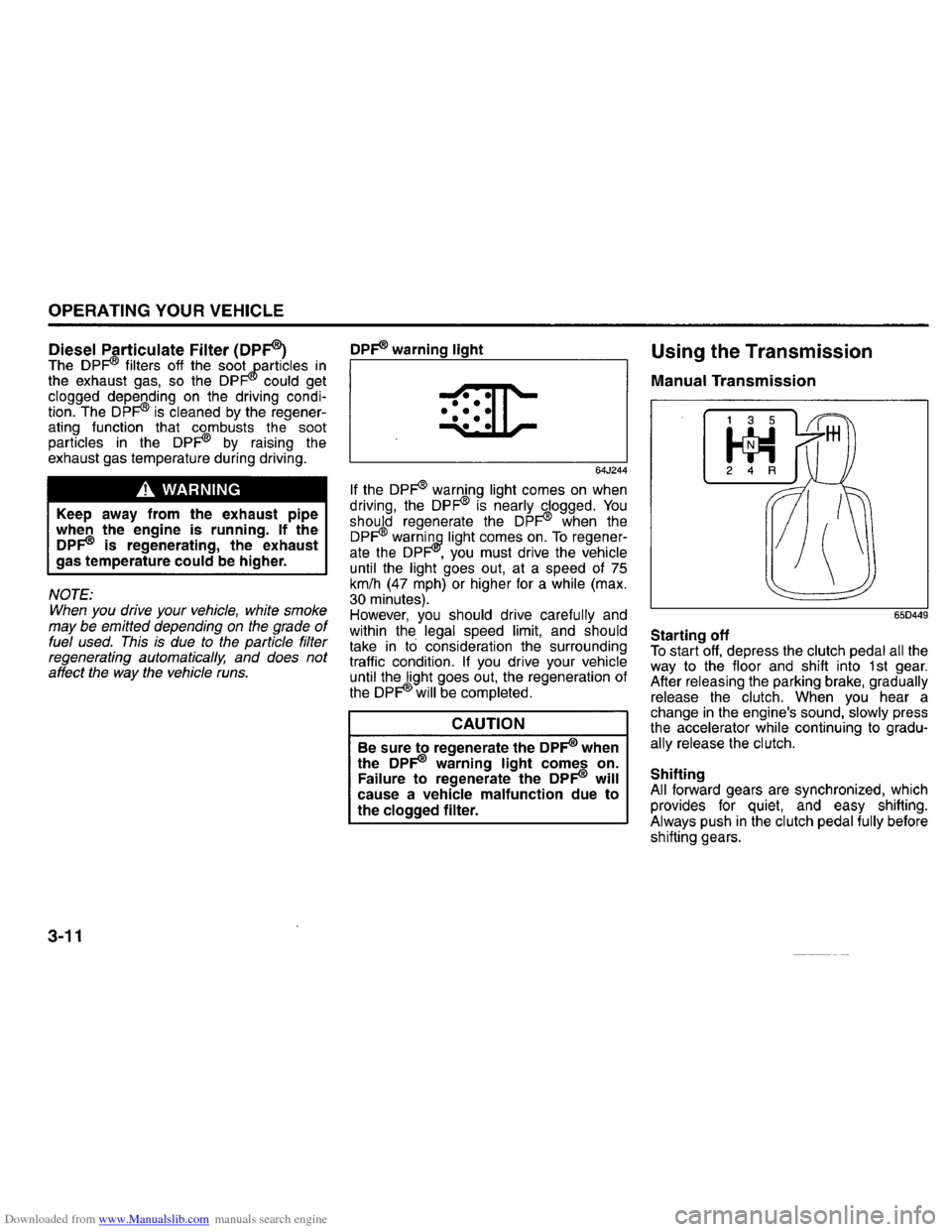
Downloaded from www.Manualslib.com manuals search engine OPERATING YOUR VEHICLE
Diesel Particulate Filter (DP~ ;::D.:..p.:..j=®----=:w:..::a::..:rn..:.:i:..::ng~lig~h:..:..:t~ _____ _____, The DPj=® filters off the soot 'particles in the exhaust gas, so the DPp!9 could get clogged depending on the driving condition. The DPPW is cleaned by the regenerating function that combusts the soot
particles in the DPPW by raising the
exhaust gas temperature during driving.
A WARNING
Keep away from the exhaust pipe
when the engine is running. If the DPj=® is regenerating, the exhaust
gas temperature could be higher.
NOTE: When you drive your vehicle, white smoke
may be emitted depending on the grade of fuel used. This is due to the particle filter
regenerating automatically, and does not
affect the way the vehicle runs.
3-11
64J244
If the DPpID warning light comes on when
driving, the DPpID is nearly clogged. You should regenerate the DPpID when the DPPW warniqg light comes on. To regenerate the DPp!9, you must drive the vehicle
until the light goes out, at a speed of 75 km/h (47 mph) or higher for a while (max. 30 minutes).
However, you should drive carefully and
within the legal speed limit, and should
take in to consideration the surrounding
traffic condition. If you drive your vehicle
until the light goes out, the regeneration of
the DPPW will be completed.
CAUTION
Be sure to regenerate the DPj=® when
the DPj=® warning light comes on.
Failure to regenerate the DPj=® will cause a vehicle malfunction due to the clogged filter.
Using the Transmission
Manual Transmission
Starting off
650449
To start off, depress the clutch pedal all the
way to the floor and shift into 1 st gear. After releasing the parking brake, gradually release the clutch. When you hear a
change in the engine's sound, slowly press
the accelerator while continuing to gradu
ally release the clutch.
Shifting All forward gears are synchronized, which
provides for quiet, and easy shifting.
Always push
in the clutch pedal fully before
shifting gears.
Page 13 of 40

Downloaded from www.Manualslib.com manuals search engine Downshifting
speeds maximum a"owable
For
M16A engine km/h (mph)
Downshifting
2nd to 1st 40 (25)
3rd
to 2nd 75 (47)
4th to 3rd
105(65)
5th to 4th 145 (90r
For J20A engine
km/h (mph)
Transfer
switch
Down- (if
equipped) position
shifting "4H" or "4L LOCK" "4H LOCK"
2nd to 1st 45 (28) 20 (13)
3rd
to 2nd 85 (53)
45 (28)
4th to 3rd
120 (75) 60 (38)
5th to 4th 165
(103)* 85 (53)*
For J24B engine km/h (mph)
Transfer
switch
Down-(if equipped) position
shifting "4H" or "4L LOCK" "4H LOCK"
2nd to 1st 50 (31) 25 (16)
3rd
to 2nd 95 (59) 45 (28)
4th
to 3rd 135 (84) 65 (41)
5th
to 4th 180 (113)* 90 (56)*
For F9Q
Diesel engine km/h (mph)
Transfer switch
Down- (if
equipped)
position
shifting "4H" or "4L LOCK" "4H LOCK"
2nd to 1st 35 (22) 15 (9)
3rd to 2nd . 60 (37) 30 (18)
4th
to 3rd 95 (59) 45 (28)
5th
to 4th 135(84)* 65 (40)*
NOTE: * You may not accelerate to the maximum
allowable speed because of the driving sit
uation and/or the vehicle condition.
OPERATING YOUR VEHICLE
CAUTION
When downshifting. to a lower gear,
make sure not to operate with the speed faster than the maximum a"owable speeds for the next lower gear, or severe engine damage can result.
EXAMPLE
54G583
Keep the engine speed so it does not get
into the red zone of tachometer.
3-12
Page 14 of 40
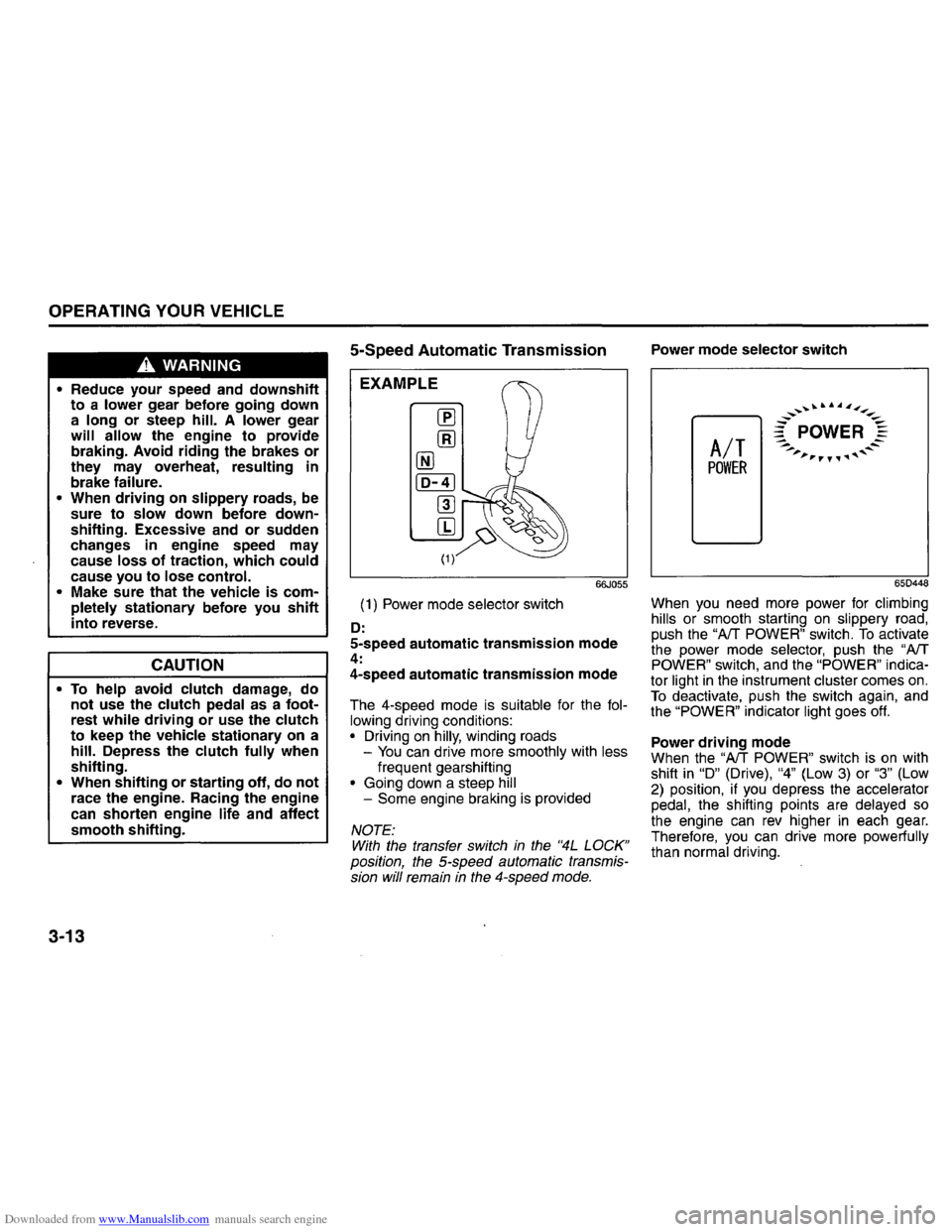
Downloaded from www.Manualslib.com manuals search engine OPERATING YOUR VEHICLE
A WARNING
• Reduce your speed and downshift to a lower gear before going down
a long or steep hill. A lower gear
will allow the engine to provide
braking. Avoid riding the brakes or they may overheat, resulting in
brake failure.
• When driving on slippery roads, be
sure to slow down before downshifting. Excessive and or sudden
changes in engine speed may
cause
loss of traction, which could cause you to lose control.
• Make sure that the vehicle is com
pletely stationary before you shift into reverse.
CAUTION
• To help avoid clutch damage, do not use the clutch pedal as a footrest while driving or use the clutch to keep the vehicle stationary on a
hill. Depress the clutch fully when
shifting.
• When shifting or starting off, do not race the engine. Racing the engine
can shorten engine life and affect
smooth shifting.
3-13
5-Speed Automatic Transmission
EXAMPLE
(1) Power mode selector switch
D:
66J055
5-speed automatic transmission mode 4: 4-speed automatic transmission mode
The 4-speed mode is suitable for the fol
lowing driving conditions: • Driving on hilly, winding roads
-You can drive more smoothly with less frequent gearshifting
• Going down a steep hill -Some engine braking is provided
NOTE:
With the transfer switch in the "4L LOCK" position, the 5-speed automatic transmission will remain in the 4-speed mode.
Power mode selector switch
A/T
POWER
650448
When you need more power for climbing
hills or smooth starting on slippery road,
push the "AfT POWER" switch. To activate
the power mode selector, push the "AfT POWER" switch, and the "POWER" indicator light in the instrument cluster comes on. To deactivate, push the switch again, and
the "POWER" indicator light goes off.
Power driving mode When the "AfT POWER" switch is on with
shift in "0" (Drive), "4" (Low 3) or "3" (Low 2) position, if you depress the accelerator
pedal, the shifting points are delayed so
the engine can rev higher in each gear.
Therefore, you can drive more powerfully than normal driving.
Page 15 of 40
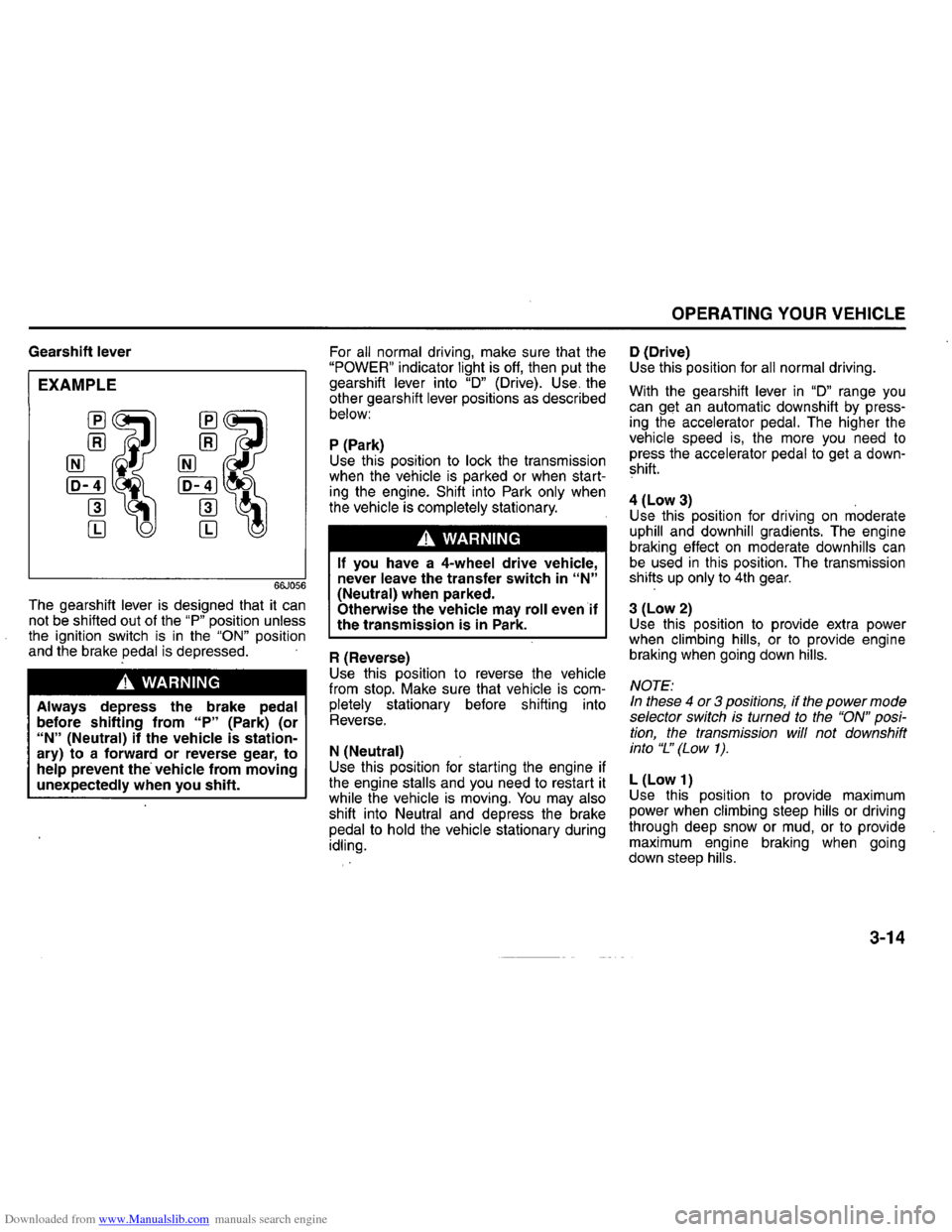
Downloaded from www.Manualslib.com manuals search engine Gearshift lever
EXAMPLE
66J056
The gearshift lever is designed that it can not be shifted out of the "P" position unless the ignition switch is in the "ON" position
and the brake pedal is depressed.
A WARNING
Always depress the brake pedal before shifting from "P" (Park) (or "N" (Neutral) if the vehicle is stationary) to a forward or reverse gear, to help prevent the vehicle from moving unexpectedly when you shift.
For all normal driving, make sure that the "POWER" indicator light is off, then put the
gearshift lever into "0" (Drive). Use. the
other gearshift lever positions as described below:
P (Park) Use this position to lock the transmission
when the vehicle is parked or when starting the engine. Shift into Park only when
the vehicle is completely stationary.
A WARNING
If you have a 4-wheel drive vehicle, never leave the transfer switch in uN" (Neutral) when parked.
Otherwise the vehicle may roll even if the transmission is in Park.
R (Reverse)
Use this position to reverse the vehicle
from stop. Make sure that vehicle is com
pletely stationary before shifting into
Reverse.
N (Neutral) Use this position for starting the engine if
the engine stalls and you need to restart it while the vehicle is moving. You may also shift into Neutral and depress the brake pedal to hold the vehicle stationary during idling.
OPERATING YOUR VEHICLE
D (Drive) Use this position for all normal driving.
With the gearshift
lever in "0" range you can get an automatic downshift by pressing the accelerator pedal. The higher the vehicle speed is, the more you need to press the accelerator pedal to get a downshift.
4 (Low 3) . Use this position for driving on moderate uphill and downhill gradients. The engine
braking effect on moderate downhills can be used in this position. The transmission
shifts up only to 4th gear.
3 (Low 2) Use this position to provide extra power
when climbing hills, or to provide engine
braking when going down hills.
NOTE: In these 4 or 3 positions, if the power mode
selector switch is turned to the "ON" position, the transmission will not downshift
into "I.!' (Low 1).
L (Low 1) Use this position to provide maximum
power when climbing steep hills or driving
through deep snow or mud, or to provide
maximum engine braking when going
down steep
hills.
3-14
Page 16 of 40
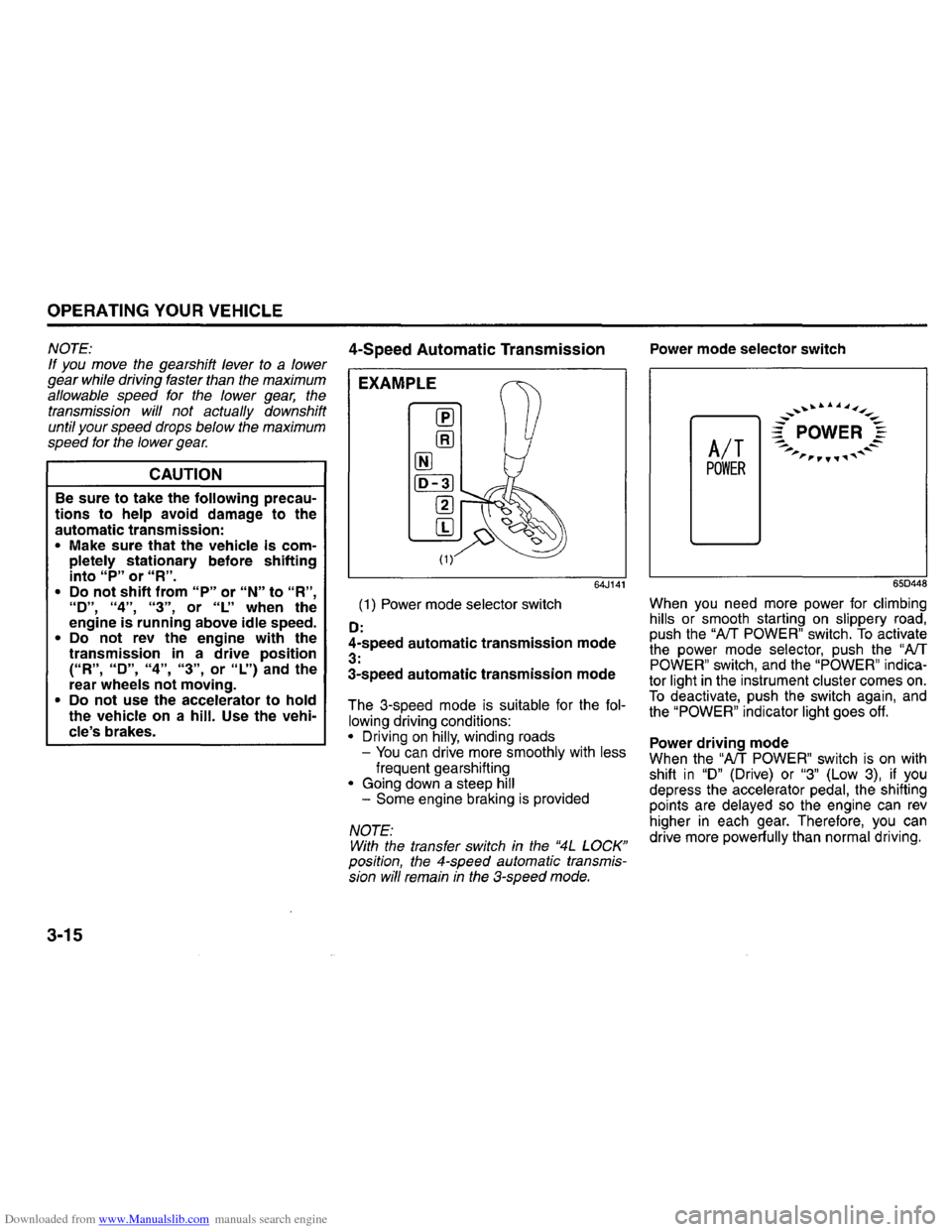
Downloaded from www.Manualslib.com manuals search engine OPERATING YOUR VEHICLE
NOTE: 4-Speed Automatic Transmission If you move the gearshift lever to a ~ower gear while driving faster than the maximum EXAMPLE allowable speed for the lower gear, the
transmission will not actually downshift
until your speed drops below the maximum
speed for the lower gear.
CAUTION
Be sure to take the following precautions to help avoid damage to the
automatic transmission:
• Make sure that the vehicle is com
pletely stationary before shifting
into "P" or "R". • Do not shift from "P" or "N" to "R", "0" "4" "3" or "L" when the
engine is'runni'ng above idle speed. • Do not rev the engine with the
transmission in a drive position ("R", "0", "4", "3", or "L") and the
rear wheels not moving. • Do not use the accelerator to hold the vehicle on a hill. Use the vehi
cle's brakes.
3-15
(1) Power mode selector switch
0:
64J141
4-speed automatic transmission mode 3: 3-speed automatic transmission mode
The 3-speed mode is suitable for the fol
lowing driving conditions: • Driving on hilly, winding roads .
-You can drive more smoothly with less frequent gearshifting • Going down a steep hill -Some engine braking is provided
NOTE: With the transfer switch in the "4L LOCK" position, the 4-speed automatic transmission will remain in the 3-speed mode. Power
mode
selector switch
A/T
POWER
650448
When you need more power for climbing hills or smooth starting on slippery road,
push the "AfT POWER" switch. To activate
the power mode selector, push the "AfT POWER" switch, and the "POWER" indicator light in the instrument cl~ster c0n:'es on. To deactivate, push the sWitch again, and
the "POWER" indicator light goes off.
Power driving mode When the "AfT POWER" switch is on with
shift in "0" (Drive) or "3" (Low 3), if you
depress the accelerator pedal, .the shifting
points are delayed so the engine can rev
higher
in each gear. Therefore, yo~. can
drive more powerfully than normal driving.
Page 17 of 40

Downloaded from www.Manualslib.com manuals search engine Slippery road mode
When the "AfT POWER" switch is on with
shift in "2" (Low 2) position, the gear will be
fixed in second while driving or when start
driving. Therefore, you can drive smoothly
on slippery road.
NOTE: • When you start driving with the gearshift lever in "2" (Low 2) position while the "AI T POWER" switch is on, the gear will be fixed in second. If you need to shift up, shift the' lever into "3" (Low 3) or "0" (Drive) position. • When the "AfT POWER" is on, if you
shift the gearshift lever from "3" (Low 3) or "0" (Drive) position to "2" (Low 2) position, the gear will be fixed in second. Gearshift
lever
64J142
The
gearshift lever is designed that it cannot be shifted out of the "P" position unless
the ignition switch is in the "ON" position and. the brake pedal is depressed.
A WARNING
Always depress the brake pedal before shifting from' "P" (Park) (or "N" (Neutral) if the vehicle is stationary) to a forward or reverse gear, to help prevent the vehicle from moving
unexpectedly when you shift.
OPERATING YOUR VEHICLE
For all normal driving, make sure that the "POWER" indicator light is off, then put the
gearshift lever into "0" (Drive). Use the
other gearshift lever positions as described
below: .
P (Park)
Use this position
to lock the transmission
when the vehicle is parked or when starting the engine. Shift into Park only when
the vehicle is completely stationary.
A WARNING
If you have a 4-wheel drive vehicle,
never leave the transfer switch in "N" (Neutral) when parked.
Otherwise the vehicle may roll even if the transmission is in Park ..
R (Reverse) Use this position to reverse the vehicle from stop. Make sure that vehicle is com
pletely stationary before shifting into
Reverse.
N (Neutral)
Use this position for starting the engine if
the engine
stalls and you need to restart it while the vehicle is moving. You may also
shift into Neutral and depress the brake
pedal to hold the I('ehicle stationary during
idling.
3-16
Page 18 of 40
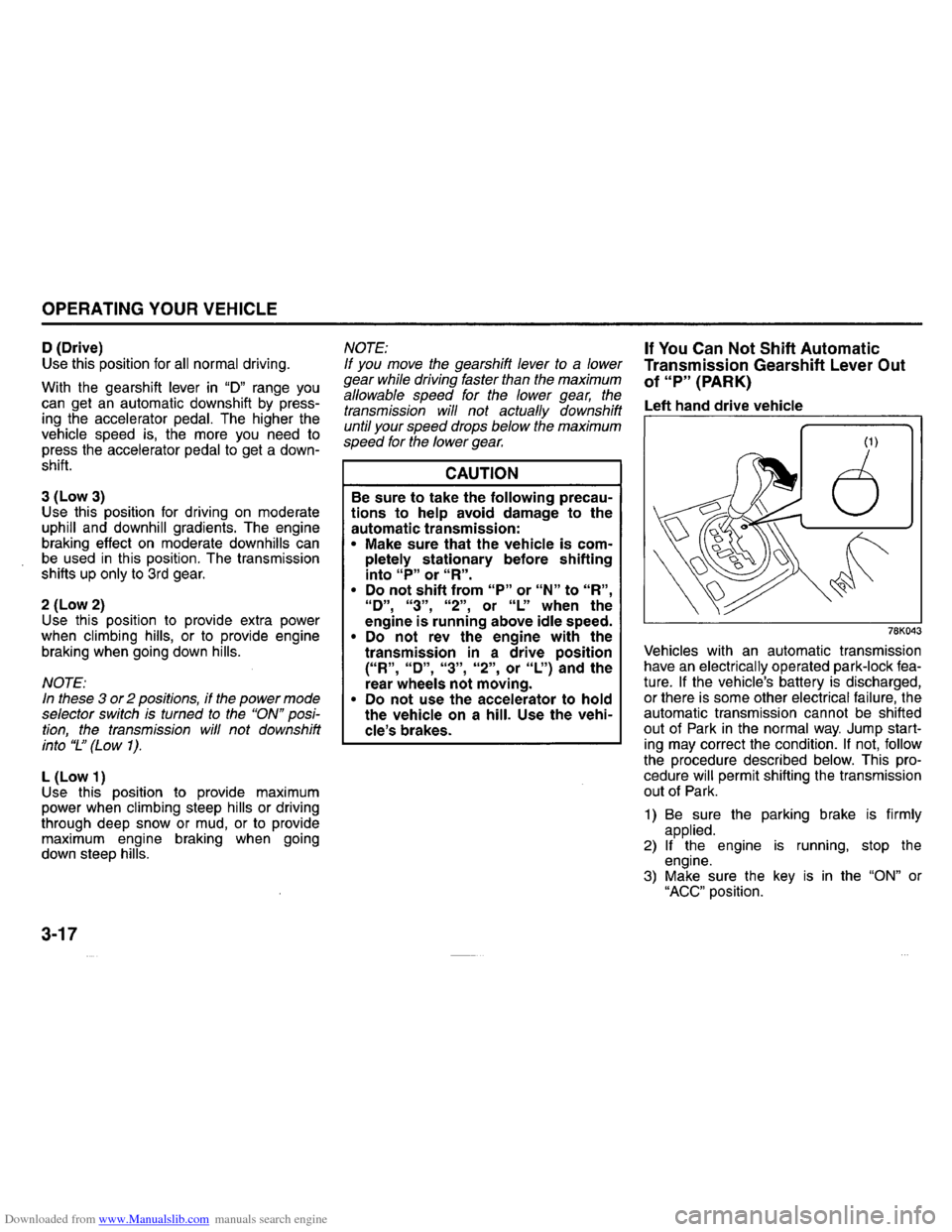
Downloaded from www.Manualslib.com manuals search engine OPERATING YOUR VEHICLE
o (Drive)
Use this position for all normal driving.
With the gearshift
lever in "D" range you can get an automatic downshift by press
ing the accelerator pedal. The higher the
vehicle speed is, the more you need to
press the accelerator pedal to get a down
shift.
3
(Low 3) Use this position for driving on moderate uphill and downhill gradients. The engine
braking effect on moderate down hills can be used in this position. The transmission
shifts up only to 3rd gear.
2 (Low 2) Use this position to provide extra power
when climbing hills, or to provide engine
braking when going down hills.
NOTE: In these 3 or 2 positions, if the power mode
selector switch is turned to the "ON" position, the transmission will not downshift
into "L.:' (Low 1).
L (Low 1)
Use this position to provide maximum
power when climbing steep
hills or driving
through deep snow or mud, or to provide
maximum engine braking when going
down steep hills.
3-17
NOTE:
If you move the gearshift lever to a lower
gear while driving faster than the maximum
allowable speed for the lower gear, the
transmission will not actually downshift
until your speed drops below the maximum
speed for
the lower gear.
CAUTION
Be sure to take the following precautions to help avoid damage to the
automatic transmission:
• Make sure that the vehicle is completely stationary before shifting into "P" or "R". • Do not shift from "P" or "N" to "R", "0", "3", "2", or "L:' when the
engine is running above idle speed. • Do not rev the engine with the transmission in a drive position ("R", "0", "3", "2", or "L:') and the rear wheels not moving. • Do not use the accelerator to hold the vehicle on a hill. Use the vehicle's brakes.
If You Can Not Shift Automatic
Transmission Gearshift Lever
Out
of "P" (PARK)
Left hand drive vehicle
78K043
Vehicles with an automatic transmission
have an electrically operated park-lock fea
ture. If the vehicle's battery is discharged,
or there is some other electrical failure, the
automatic transmission cannot be shifted
out of Park in the normal way. Jump start
ing may correct the condition. If not, follow the procedure described below. This pro
cedure will permit shifting the transmission
out of Park.
1) Be sure the parking brake is firmly
applied.
2) If the engine is running, stop the
engine.
3) Make sure the key is in the "ON" or "ACC" position.
Page 19 of 40
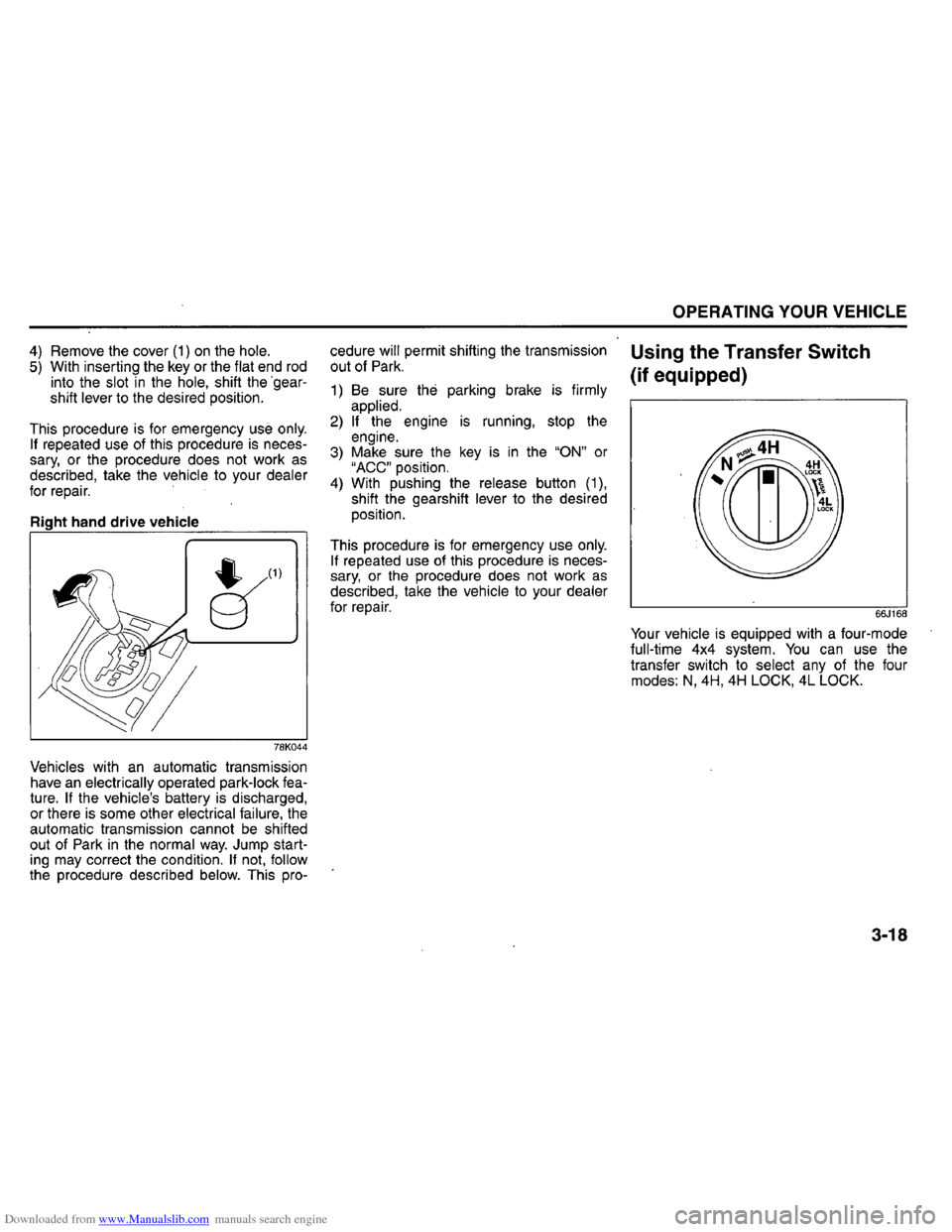
Downloaded from www.Manualslib.com manuals search engine 4) Remove the cover (1) on the hole. 5) With inserting the key or the flat end rod into the slot in the hole, shift the 'gear
shift lever to the desired position.
This procedure
is for emergency use only. If repeated use of this procedure is necessary, or the procedure does not work as described, take the vehicle to your dealer for repair. '
Right hand drive vehicle
~(1)
78K044
Vehicles with an automatic transmission have an electrically operated park-lock fea
ture. If the vehicle's battery is discharged,
or there is some other electrical failure, the
automatic transmission cannot be shifted
out of Park in the normal way. Jump start
ing may correct the condition. If not, follow the procedure described below. This pro- cedure
will permit shifting the transmission
out of
Park.
1) Be sure the parking brake is firmly
applied.
2) If the engine is running, stop the
engine.
3) Make sure the key is in the "ON" or "ACC" position. 4) With pushing the release button (1),
shift the gearshift lever to the desired
position.
This procedure
is for emergency use only. If repeated use of this procedure is necessary, or the procedure does not work as described, take the vehicle to your dealer for repair.
OPERATING YOUR VEHICLE
Using the Transfer Switch
(if equipped)
66J168
Your vehicle is equipped with a four-mode full-time 4x4 system. You can use the
transfer switch to select any of the four
modes: N, 4H, 4H LOCK, 4L LOCK.
3-18
Page 20 of 40

Downloaded from www.Manualslib.com manuals search engine OPERATING YOUR VEHICLE
(4) (6) (7)
3-19
(9)
64J143
(1) Front differential (2) Engine
(3) Transmission
(4) High/Low
clutch (5) Transfer case
(6) Center differential (7) Differential lock clutch (8) Chain
(9) Rear propeller shaft
(10) Rear differential (11) Front propeller shaft